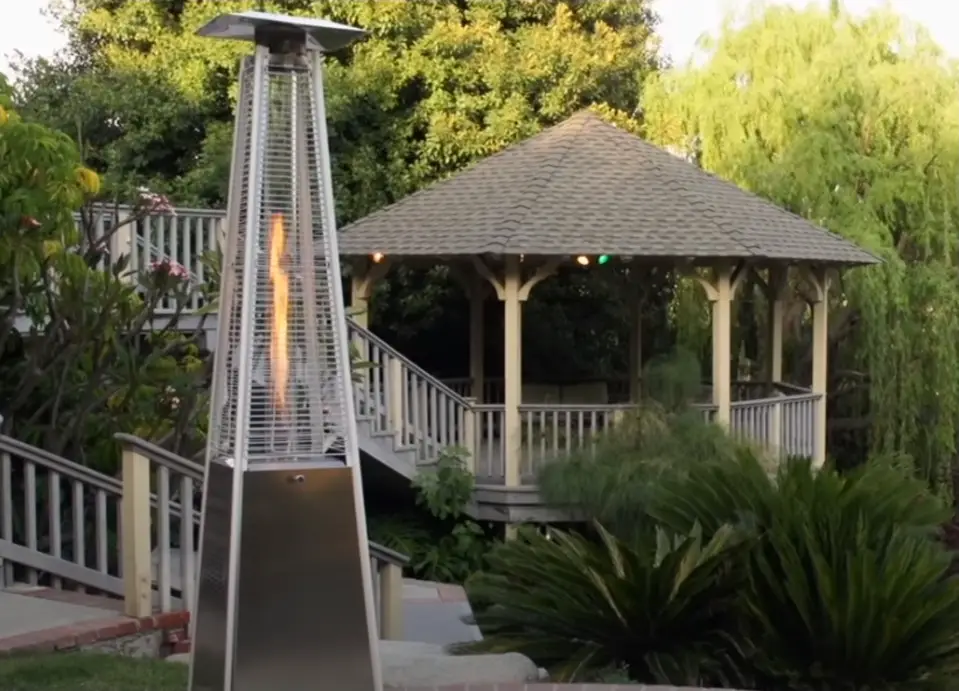Patio heaters have become popular in the home market as a means to extend the outdoor season that you can enjoy out on the patio and deck of your home. Restaurants also use this technology to give their patrons the choice to sit outside, even on a chilly evening, and remain comfortable. But how effective are the styles and shapes? Reflectors built as part of the heater do they really work and make that much of a difference?
All patio heaters rely on infrared heat to feel warmth outside. Infrared heat is part of the invisible light spectrum; therefore, the shape and design play a significant role. Patio heaters utilize this aspect in their shape by reflecting and directing the infrared heat down and toward places where heat is desired.
As more people see the benefit of spending more time outside, decks and patios’ popularity is ever-increasing among homeowners. In order to enjoy this outdoor space for more extended periods in the cooler seasons of the year, a patio heater is often used to keep people warm outdoors in the cool of the evening.
The reflector on the patio heater will affect the efficiency of the heater’s heat distribution and the effectiveness of the heater. Let’s dig a little deeper why and learn where to place the heaters.
Are Patio Heaters with Reflectors Effective?
In short? Yes. However, why are they effective? Well, we all know that heat does have a tendency to rise. We also know that the heated metal or elements of a heater give off infrared, an invisible light to our human eyes.
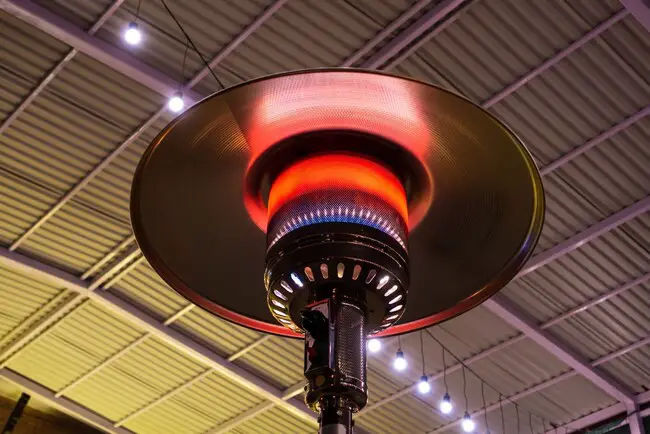
If we put those facts together, we create heat that goes out and up, like all heat goes. Therefore, we reflect the heat going up and direct it down to where we are sitting and enjoying life to improve efficiency. The reason heat can be reflected because of the infrared light spectrum on a reflective surface.
So we know why patio heaters have big reflectors or are designed to heat a specific area. How do their shapes affect how they heat? Learn more about how good fasten on reflectors work to help deflect heat.
Patio Heater Shapes and Reflector Shapes and Their Corresponding Output.
There are various shapes and designs of patio heaters. The more popular they become, the more demand there is for alternative designs on the market.
There are enough choices available to find a heater that will fit in with your décor, space requirements, and type of fuel.
Some versions use electricity and can be mounted to the roof of your deck, gazebo, or Pergola. Thus, directing heat down and onto the patio, free-standing propane-powered versions, and even table-top versions that will localize the heat around the table and take up less floor space.
All of these heaters work on the same principle that we touched on above by radiating infra-red heat. The fuel, or electricity, generates heat which causes an element of some description to heat up and glow red-hot. Their heat is then distributed to the surrounding area utilizing a reflector.
The reflector is the component that will determine the effectiveness of your patio heater. Therefore, it is an essential aspect of the heater that you should consider when looking for a good patio heater.
The effectiveness of the patio heater will be determined by the effectiveness of the reflector. The significance of the reflector, in turn, will be affected by size, shape, and material.
Most patio heater reflectors are effective and do an excellent job at evenly distributing the heat and determining the area that the heater can effectively heat.
Size Of The Patio Heater Reflector
The patio heater reflector’s size will influence the distance from the heater that the heat can be felt. There will be a point where the reflector can be too big and where the extra size no longer plays a role, which is why patio reflectors are of a certain size.
If the reflector is too small, much of the heat will escape around the edges of the reflector, which will result in less heat being directed to where you need it. A reflector that is too small will therefore limit the effective range of the patio heater.
If the reflector is too large, it will absorb too much of the heat, and there will be less heat to be directed to the desired location. As a result, a reflector that is too large will be inefficient and reduce the effective range rather than increase the range.
The conclusion that we can draw from this is that there is a lower limitation and an upper limitation to the size of the reflector, which will influence its effectiveness.
The heater’s BTU rating needs to be taken into account for the appropriately sized reflector as well. Lower BTU-rated heaters would generally have a smaller reflector; otherwise, the reflector will absorb too much heat and reduce the heater’s effectiveness.
Shape Of The Patio Heater Reflector
With many different designs of patio heaters coming available on the market, some designs are intended more for aesthetics than efficient heating.
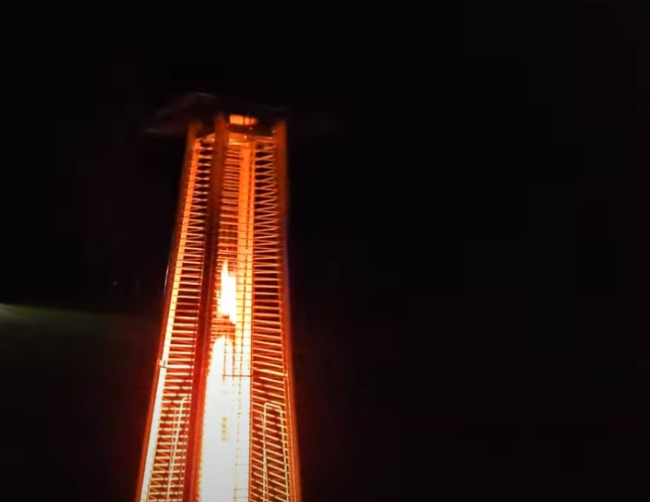
The shape of the reflector will play a role in the effective distribution of the heat emitted by the heater. With the free-standing mushroom-style heaters, a round-shaped reflector provides the most efficient and even distribution of the heat.
Square Reflectors
Square-shaped reflectors produce hotspots and cold spots in the range of the reflected heat and, as a result, are less effective in distributing the heat evenly. This shape of the reflector may be of interest if you want to direct the heat in one particular direction rather than an even 360-degree distribution of the heat.
Think that the shape of the reflector is the shape of the heating area.
Tube Reflectors
Quartz-tube reflectors are usually found in pyramid-shaped free-standing patio heaters, and the reflector is a tubular length of quartz-glass. These heaters are elegant and attractive since the flame from the propane burning can be seen up the length of the tube, and it gives a romantic ambiance of an open fire to space.
The glass tube acts as the reflector and will radiate the heat 360-degrees around the tube. These heaters often have an additional reflector at the top of the heater to direct some of the heat downward.
Since the natural tendency of heat is to want to travel upwards, these heaters are less effective and have less of an effective range than the larger top-mounted circular reflectors.
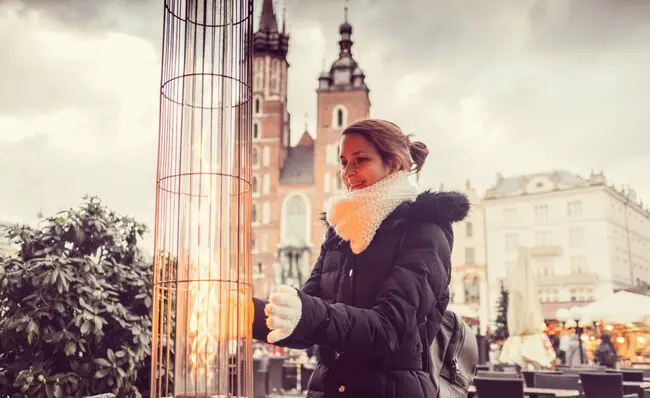
The attractiveness of these heaters may be their main selling point, but as a buyer, you need to be aware that they will not heat the same amount of space as an equivalent BTU heater with a top-mounted circular reflector.
Circular Reflectors
Circular reflectors that are mounted at the top of the heater are the most efficient and effective of the reflector shapes.
We have all learned during our basic schooling that hot air rises, and this principle needs to be applied in the decision of the most effective patio heater reflector.
This natural tendency of the heat wanting to travel upwards means that we need to re-direct the heat to where we want it. This is one of the main purposes and functions of the patio heater reflector.
The mushroom-style free-standing reflectors take this rising heat principle into consideration. They are the reason for their placement at the top of the heater.
The slightly downward-curved shape re-directs the rising heat back down to a lower level where it is needed and most effective at providing warmth to the people sitting around the heater.
Material Of The Patio Heater Reflector
The material that the reflector is made from is also a consideration in the reflector’s overall effectiveness.
Generally, patio heater reflectors are made from metal, and the preferred metal is stainless steel. The next notch down would be aluminum. Due to the nature of patio heaters spending most of their lives outdoors, they need to be made from durable material and can withstand the corrosion forces from being exposed to the elements.
The quality of the stainless steel and the thickness of the steel used will either contribute or detract from the effectiveness of the reflector.
A steel that is too thick will absorb a large quantity of the heat from the heater, and the metal will radiate this heat from the rear of the reflector, away from where the heat is needed in front of the reflector.
If the metal used in the reflector is too thin, it will become damaged from the high heat produces by the heater, and it will eventually burn through and corrode the metal. The thin steel will heat up quickly, but as a result of the thin material, it will also “leak” a lot of heat at the back of the reflector and make the reflector inefficient.
Once again, there is a happy medium between the two dimensions that make for an efficient reflector. Generally, cheaper reflectors will be made from thinner materials and lower quality materials, which is why these reflectors can be sold at a lower price.
The Color Of The Reflector
The purpose of a reflector is to reflect the heat rather than absorb the heat into the material of the reflector.
The best way to achieve a maximum reflection of the heat is to have a shiny-colored reflector that will reflect the heat rather than absorb it. Painted reflectors do not work well because they do not reflect the heat effectively, and the heat will eventually damage the paint and it will peel off or blister.
Painted reflectors are generally an indication of an inferior product and should be avoided. Also, keeping your patio heater reflector as clean as possible will increase its effectiveness in sending the heat where it is needed.
Heating Direction Of The Patio Heater Reflector
As we have seen, the natural flow of the heat is in an upward direction and requires us to re-direct the heat by means of the reflector.
This fact makes the downward direction of patio heater reflectors more effective than outward directing reflectors.
Outward directing reflectors, such as the quartz-tube reflectors, have a very little downward direction of the heat. That means that the heat projects outward but very quickly starts to rise and dissipate into the air. This limits the effective distance from the heater that people will feel the warming effects.
The downward directing reflectors re-direct all the heat down towards the people sitting around the heater and allow the heat to be felt a further distance from the heater. These reflectors make more of the available heat accessible to heating a wider area around the heater.
Add-On extra reflectors, for your patio heaters. These are extra add-on parts that can have a big advantage. To me, the biggest advantage is to deflect heat that may go toward the house or out over a railing.
By adding this type of additional reflector, you can increase the heat toward where you need it. That is, away from heating, let’s say the vinyl siding or a bush. To learn more about our opinion and our favorite add-on patio heater reflectors, check out this article.
Height Of The Patio Heater Reflector
If a reflector is placed at too great a height, it will reduce the effectiveness of the heat generated. Even downward directing reflectors, if placed too high, will be ineffectual in directing enough of the heat downwards to be felt by the people at the base of the heater.
The large space between the reflector and the people needing the heat will allow the warmth to counteract the downward direction of the reflector and once again start to rise. This heat will then be lost to the atmosphere.
The ideal height of a reflector to be efficient in directing the heat downward is about 7.5 to 8 feet above the deck or patio floor.
The Problems Of An Ineffective Patio Heater Reflector
A patio heater reflector that does not direct the heat effectively will have a number of repercussions for the homeowner.
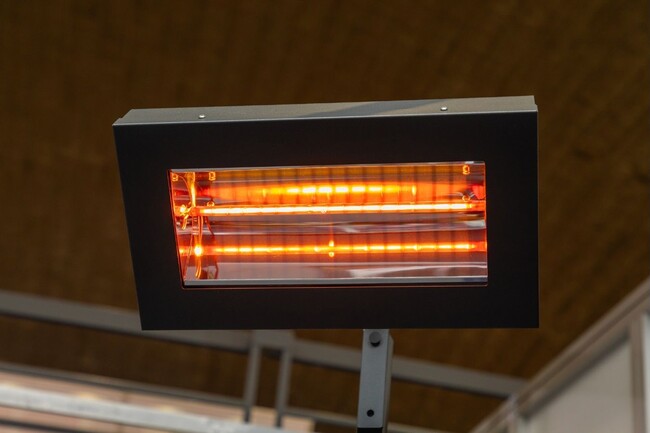
The heater will not heat the space effectively, which will either require more heaters to heat the space or make the space too cold to be comfortable to be outside. It may also require the people to huddle closer to the base of the heater, which increases the risk of knocking the heater over.
An inefficient reflector will also consume more fuel or electricity, which will make the heater expensive to run. If the heater is expensive to operate, you will be reluctant to use it often, which will defeat the object of having a patio heater in the first place.
Learn how much noise should a patio heater actually make operating correctly.
How To Increase The Effectiveness Of Your Patio Heater Reflector
The best way to improve the effectiveness of your patio heater is to understand the factors that will limit its effectiveness.
One of the main factors that reduce the effectiveness of a patio heater is the wind. Even a light breeze will quickly dissipate the heat from the heater, even with an effective downward-directing mushroom-style patio heater.
This isn’t so much the wind blowing the infrared heat away, but the wind chill effect negatively impacting the radiant warmth.
If you have prevailing winds in your location during the seasons when you want to use your patio heater, then an effective measure to increase the efficiency of your heater would be to block the incoming wind on the side where the wind normally comes from.
This can be done in the form of plants that can act as windbreaks or fitting a roll-up canvas wall to the appropriate side of your patio. The roll-up wall can be tucked away during the summer months but lowered to increase the effectiveness of your heater in the cooler seasons or when you want to sit outside.
Another way to increase the effectiveness of your patio heater reflector is to install a roof on your patio, which can trap the heat and make the heater more efficient. A louvered roof will allow you to open the roof in summer to allow the heat to escape but trap the heat in the cooler seasons.
What Other Factors Affect The Reflectors Effectiveness?
The patio reflector can only reflect the heat that the heater puts out. Thus, if your heater is underpowered and outputs a lower BTU, then the heat reflected by the reflector will be less, and it will not be able to cover as wide an area.
The power of heaters are measured in BTU’s, which is an acronym for British Thermal Unit. The higher the BTU of the heater, the more heat it will output and the larger the area it will be capable of heating, depending on the effectiveness of the reflector.
Patio heaters’ power output generally starts at about 10 000 BTUs and ranges up to in excess of 75 000 BTUs. To give you an idea of the area that the heater will be able to heat based on the BTU rating, you examine the following data.
| Heater BTU | Area | Effective Distance (radius) From Heater |
|---|---|---|
| 10 000 BTU | 64 Square feet | 4 feet |
| 46 000 BTU | 320 Square feet | 10 feet |
| 75 000 BTU | 448 Square feet | 30 feet |
Conclusion
These numbers can be affected by the factors such as whether your patio has a roof or not, if there is a wind blowing or whether you can close off the sides of your patio.
Patio heater style and reflector shapes really do work, but the effectiveness with which they work depends on their actual shape, design, and size.
Sometimes the heaters that are designed for aesthetics and décor will, thus, lose some of their heating effectiveness as the design of the reflector and the heater is changed for looks rather than effectiveness.
Your choice of patio heater and reflector will mostly be determined by the space you need to heat. For a smaller area, a pyramid, quartz-tube reflector heater may be sufficient for your needs and will be appealing to the eye. Our recommended Quartz Tube heater on Amazon.
But if your area is larger, you would do better to choose a heater with a more effective reflector to get better heating and keep your fuel costs down. Our recommended Patio Heater on Amazon.


